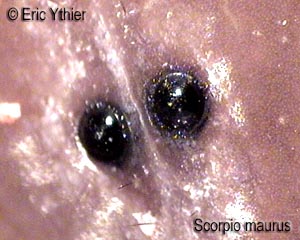Anatomy
Page 1 of 1
 Anatomy
Anatomy
The Prosoma
General
The Prosoma means that any previous part of the anatomy of a scorpion. It is mainly composed of the cephalothorax, the pedipalps and chelicerae.
On the dorsal side are the eyes, and on the ventral side are the hips (or coxa).
Detail
1 °) The pedipalps
Towering Members, the pedipalps have a high concentration of trichibotries, which makes the fundamental sensory elements for the scorpion. They are composed of six parts:
The whole formed by the tibia and the Tarsus is called 'hand', or more commonly clamp. The tibia is fixed hand finger, while Tarsus corresponds to the mobile finger.

(Close-up on French Buthus occitanus fingers.
Photo from The Scorpion Fauna site. Thanks to Eric Ythier.)
On the pedipalps can be found of hulls.
2 °) The cephalothorax
It corresponds to the first "plate" of the carapace of scorpion, on which are usually the eyes, although some species are sometimes lacking (ex: Belisarius xambeui, small scorpion cavernicol French).
It identifies two groups of very distinct eyes:

(Close-up on median eyes of Scorpio Maurus.
Photo from The Scorpion Fauna site. Thanks to Eric Ythier.)

(Close-up on lateral eyes of Scorpio Maurus.
Photo from The Scorpion Fauna site. Thanks to Eric Ythier.)
In the scorpion, the eyes are secondary sensory elements.
On the cephalothorax can be found of hulls.
3 °) The chelicerae
Sorts of tweezers with fine bristles, the chelicerae are used mainly to food and drink.
The chelicerae are often decisive elements for systematists.

(Close-up on the chelicerae of Leiurus quinquesrtiuatus.
Photo from The Scorpion Fauna site. Thanks to Eric Ythier.)
4 °) Legs
Present at the number 8 and distributed in 4 pairs, the legs are attached to the body on the ventral side of the scorpion, at the level of the cephalothorax. The pedipalps, as they are composed of six parts:

(Close-up on a Leiurus quinquesrtiuatus Tarsus.
Photo from The Scorpion Fauna site. Thanks to Eric Ythier.)
5 °) The genital operculum
On the ventral side in the middle of the hips is the operculum genital, composed of two plates that form a valve. Under this lid hiding the reproductive organs of the scorpion:
General
The Prosoma means that any previous part of the anatomy of a scorpion. It is mainly composed of the cephalothorax, the pedipalps and chelicerae.
On the dorsal side are the eyes, and on the ventral side are the hips (or coxa).
Detail
1 °) The pedipalps
Towering Members, the pedipalps have a high concentration of trichibotries, which makes the fundamental sensory elements for the scorpion. They are composed of six parts:
- hip (or coxa; fixed part connected to the cephalothorax)
- the trochanter (movable joint between hip and femur)
- the femur (long part mobile)
- the patella (or brachium; second long mobile part)
- the tibia (fixed finger)
- Tarsus (mobile finger)
The whole formed by the tibia and the Tarsus is called 'hand', or more commonly clamp. The tibia is fixed hand finger, while Tarsus corresponds to the mobile finger.

(Close-up on French Buthus occitanus fingers.
Photo from The Scorpion Fauna site. Thanks to Eric Ythier.)
On the pedipalps can be found of hulls.
2 °) The cephalothorax
It corresponds to the first "plate" of the carapace of scorpion, on which are usually the eyes, although some species are sometimes lacking (ex: Belisarius xambeui, small scorpion cavernicol French).
It identifies two groups of very distinct eyes:
- The median group, centered prominently expenses on top of the cephalothorax, can contain up to two pairs of eyes:

(Close-up on median eyes of Scorpio Maurus.
Photo from The Scorpion Fauna site. Thanks to Eric Ythier.)
- The side groups, arranged symmetrically on the edges of the carapace may be two to four pairs of eyes:

(Close-up on lateral eyes of Scorpio Maurus.
Photo from The Scorpion Fauna site. Thanks to Eric Ythier.)
In the scorpion, the eyes are secondary sensory elements.
On the cephalothorax can be found of hulls.
3 °) The chelicerae
Sorts of tweezers with fine bristles, the chelicerae are used mainly to food and drink.
The chelicerae are often decisive elements for systematists.

(Close-up on the chelicerae of Leiurus quinquesrtiuatus.
Photo from The Scorpion Fauna site. Thanks to Eric Ythier.)
4 °) Legs
Present at the number 8 and distributed in 4 pairs, the legs are attached to the body on the ventral side of the scorpion, at the level of the cephalothorax. The pedipalps, as they are composed of six parts:
- hips (or coxa; large plate sets present on the ventral side)
- the trochanter (movable joint between hip and femur)
- the femur (long part mobile)
- the mobile part long second patella)
- the long second tibia mobile part)
- Tarsus (composed of two small clawed)

(Close-up on a Leiurus quinquesrtiuatus Tarsus.
Photo from The Scorpion Fauna site. Thanks to Eric Ythier.)
5 °) The genital operculum
On the ventral side in the middle of the hips is the operculum genital, composed of two plates that form a valve. Under this lid hiding the reproductive organs of the scorpion:
- For males: copulatory hooks that are used to remove the hemispermatophore during courtship.
- For the female: the genital orifice at the bottom of which lie the eggs to fertilize, or larvae in training.
Last edited by Lioth on Sun May 19, 2013 12:27 pm; edited 1 time in total
 Re: Anatomy
Re: Anatomy
The Mesosoma
General
The Mesosoma is the central part of the anatomy of a scorpion. It is mainly composed of tergites and sternites.
On the ventral side are also pectins and stigma.
Detail
1 °) Tergites
Always present seven tergites are the "plates" that form the dorsal carapace of scorpion. Overlap allows an optimal protection of the skin, while providing a good range of motion.
On tergites are often many hulls.
2 °) Sternites
Like tergites, sternites are the seven "plates" that form the ventral carapace of scorpion. Often, the hips and the Combs cover 1 ° and 2 ° sternites, making them difficult to differentiate.
3 °) Pectin
Also called "Combs", pectins are located just behind the fourth pair of legs. These highly mobile organs are unique to the scorpion: these are essential sensory elements which he uses to "feel" the objects on which it is located.
The size, the shape and the number of "teeth" of each comb can sometimes identify the species and sex of some specimens.

(Close-up on a comb of Parabuthus transvaalicus.
Photo from The Scorpion Fauna site. Thanks to Eric Ythier.)
4 °) The stigmata
Are residues of gills from the era where the ancestors of scorpions were marine animals. Present in pairs on the 3 °, 4 °, 5 ° and 6 ° sternites, these are small valves under which lie the lung pockets of the scorpion. It can open and close these stigmas at will in order to control the amount of air that he breathes, and avoid that sand or earth not seeps in too much in his respiratory tract.

(Close-up on a stigma of Nebo hierichonticus.
Photo from The Scorpion Fauna site. Thanks to Eric Ythier.)
General
The Mesosoma is the central part of the anatomy of a scorpion. It is mainly composed of tergites and sternites.
On the ventral side are also pectins and stigma.
Detail
1 °) Tergites
Always present seven tergites are the "plates" that form the dorsal carapace of scorpion. Overlap allows an optimal protection of the skin, while providing a good range of motion.
On tergites are often many hulls.
2 °) Sternites
Like tergites, sternites are the seven "plates" that form the ventral carapace of scorpion. Often, the hips and the Combs cover 1 ° and 2 ° sternites, making them difficult to differentiate.
3 °) Pectin
Also called "Combs", pectins are located just behind the fourth pair of legs. These highly mobile organs are unique to the scorpion: these are essential sensory elements which he uses to "feel" the objects on which it is located.
The size, the shape and the number of "teeth" of each comb can sometimes identify the species and sex of some specimens.

(Close-up on a comb of Parabuthus transvaalicus.
Photo from The Scorpion Fauna site. Thanks to Eric Ythier.)
4 °) The stigmata
Are residues of gills from the era where the ancestors of scorpions were marine animals. Present in pairs on the 3 °, 4 °, 5 ° and 6 ° sternites, these are small valves under which lie the lung pockets of the scorpion. It can open and close these stigmas at will in order to control the amount of air that he breathes, and avoid that sand or earth not seeps in too much in his respiratory tract.

(Close-up on a stigma of Nebo hierichonticus.
Photo from The Scorpion Fauna site. Thanks to Eric Ythier.)
Last edited by Lioth on Sun May 19, 2013 12:27 pm; edited 6 times in total
 Re: Anatomy
Re: Anatomy
The Metasoma
General
The Metasoma refers to any of the posterior part of the anatomy of a scorpion, "tail". It is mainly composed of articulated rings and the telson.
It is at the level of the articulation between the fifth ring sits the anus and the telson.
Detail
1 °) Rings
Still present with the number five, the rings are articulated elements systematists observe carefully. In effect, they are often covered hulls and/or trichobotries for differentiating species. In addition, at some scorpions, the fifth ring (which is generally the longest) to differentiate male and female with some sexual dimorphisms (size, towing...). It is at the end of this fifth ring sits the telson.
2 °) Anus
Like most animals, the scorpion rejects non digestible food in the form of feces. They present themselves as a thick substance white or black, expelled through an orifice located at the joint between the fifth ring of the metasoma and the telson.

(Close-up on an anus of Hadrurus spadix.
Photo from The Scorpion Fauna site. Thanks to Eric Ythier.)
3 °) The telson
Symbol of death in many cultures, the scorpion telson serves both secrete, storing and inoculating the venom. It consists of two parts:

(Close-up on the 4 ° and 5 ° rings as well as the telson of an Androctonus bicolor.)
Photo from The Scorpion Fauna site. Thanks to Eric Ythier.)
To avoid that it breaks when the scorpion stings a prey to the thick shell, the end of the sting is very solid and often composed of a zinc-rich metal alloy.
General
The Metasoma refers to any of the posterior part of the anatomy of a scorpion, "tail". It is mainly composed of articulated rings and the telson.
It is at the level of the articulation between the fifth ring sits the anus and the telson.
Detail
1 °) Rings
Still present with the number five, the rings are articulated elements systematists observe carefully. In effect, they are often covered hulls and/or trichobotries for differentiating species. In addition, at some scorpions, the fifth ring (which is generally the longest) to differentiate male and female with some sexual dimorphisms (size, towing...). It is at the end of this fifth ring sits the telson.
2 °) Anus
Like most animals, the scorpion rejects non digestible food in the form of feces. They present themselves as a thick substance white or black, expelled through an orifice located at the joint between the fifth ring of the metasoma and the telson.

(Close-up on an anus of Hadrurus spadix.
Photo from The Scorpion Fauna site. Thanks to Eric Ythier.)
3 °) The telson
Symbol of death in many cultures, the scorpion telson serves both secrete, storing and inoculating the venom. It consists of two parts:
- Gall, in which venom is secreted and stored.
- The aculeus, or sting, which is used to inoculate the venom.

(Close-up on the 4 ° and 5 ° rings as well as the telson of an Androctonus bicolor.)
Photo from The Scorpion Fauna site. Thanks to Eric Ythier.)
To avoid that it breaks when the scorpion stings a prey to the thick shell, the end of the sting is very solid and often composed of a zinc-rich metal alloy.
Page 1 of 1
Permissions in this forum:
You cannot reply to topics in this forum|
|
|







